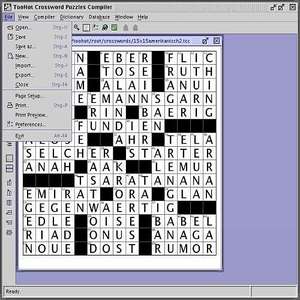

- #CROSSWORD EDITOR SOFTWARE MANUAL#
- #CROSSWORD EDITOR SOFTWARE FULL#
- #CROSSWORD EDITOR SOFTWARE SOFTWARE#
Any of these can be saved as a template, so when you go to create a new puzzle (let’s say ‘Round Tour’ from that list) all of those previously specified parameters will be in place.
#CROSSWORD EDITOR SOFTWARE FULL#
What about those “Other templates”? Whenever you create a puzzle you have full control over its appearance – cell size, line colours and weights, block colours, fonts etc. For me, that alone is worth the entrance fee. You can see immediately how wide a variety of puzzles it’s designed to help you to produce.
#CROSSWORD EDITOR SOFTWARE SOFTWARE#
What does it offer? Well, when you launch the software you’ll see this: Remember, CC is a professional package used by the majority of newspapers – it’s not a toy! In terms of what it offers the crossword setter it is at least equivalent to what PhotoShop offers the image manipulator for something like £600. Bought separately these would amount to the princely sum of €188 but you can go all-in for a very reasonable €129 (£109).
#CROSSWORD EDITOR SOFTWARE MANUAL#
The basic package currently costs €39, but there are a range of add-ons including WordWeb Pro (dictionary and thesaurus), various word lists and a Pro Grid Filler which is most useful for heavily or fully cross-checked puzzles where a manual fill can be extremely difficult. Creating a cryptic crossword (especially) is a labour of love, and full-featured crossword software can actually inspire you to create even better work. But there’s so much more to it than just artwork.

Even if newspapers aren’t your target, the ability to export all elements of your work at high quality is of huge benefit. In most cases, though, and particularly as regards newspapers, they will already be using either CC or TEA and will expect submissions in one of those formats. OK, if you’ve put together a crossword and want a publication to accept it they will, at the very least, need high resolution grid artworks and typographically faultless clues. I know this because, after contacting author Ross Beresford with a small tweak suggestion, he told me a new release was in the pipeline. Although I can’t go into detail, I can say there are significant improvements to what is already an outstanding piece of software, and many of these improvements revolve around the sophisticated wordplay tricks employed by (typically) thematic barred puzzle setters. I’ll try to run through what each of these packages does/doesn’t offer, but from the outset it’s worth mentioning that a new release of TEA is on the way. They both offer an extensive range of features equally they both have fundamental differences, which is the reason I use both! More of that later. For ease of reference I’ll refer to the former as CC and the latter as TEA (based on its former name of TEA and Sympathy). He blogs here and tweets as there is such a thing as good freeware, but when it comes to creating publishable crosswords the only realistic option is to buy a professional package, and for serious setters there are just two big names – Crossword Compiler and Crosswordman. By the end of this article, you will have an overview of the features these setting tools provide, their differences and some tips to help you decide which one to buy.Īnax is a professional cryptic crossword setter for the top daily crosswords in UK - The Independent, the FT as Loroso and anonymously in The Times. Guest author Dean Mayer (Anax) talks about tools that he finds most useful as a crossword setter.


 0 kommentar(er)
0 kommentar(er)
